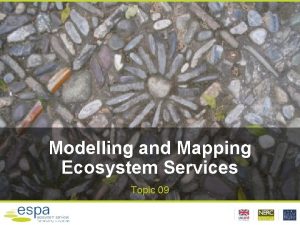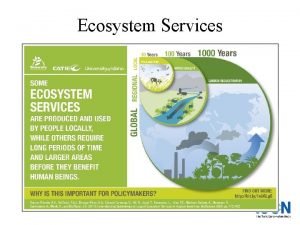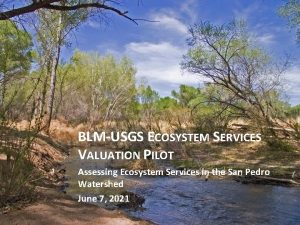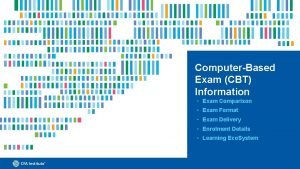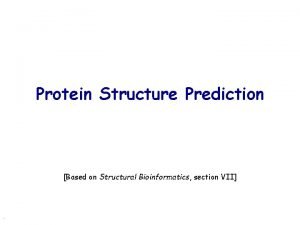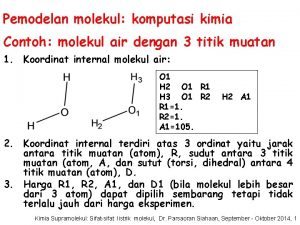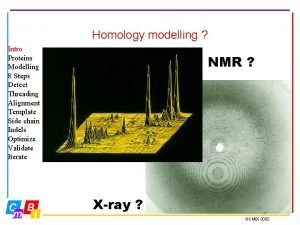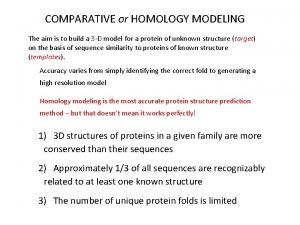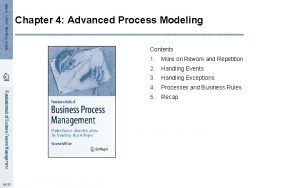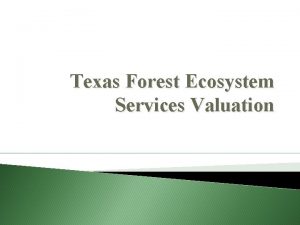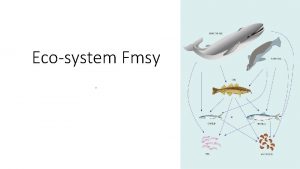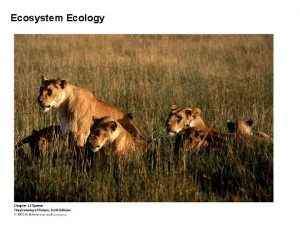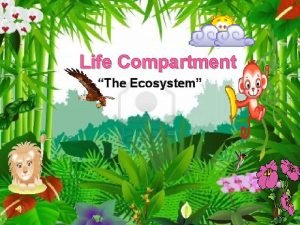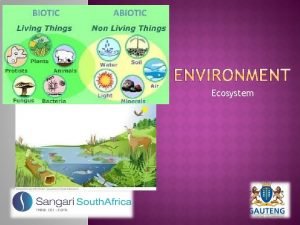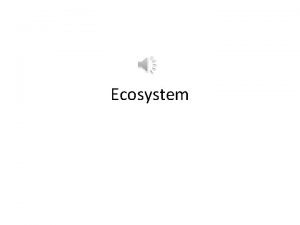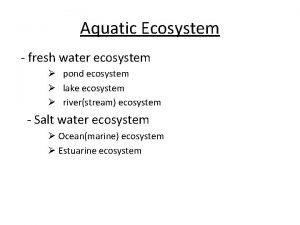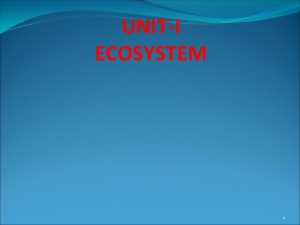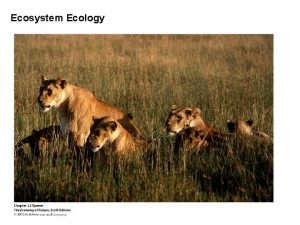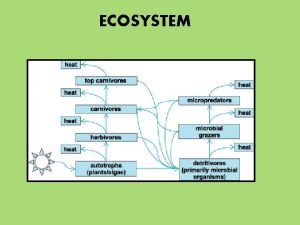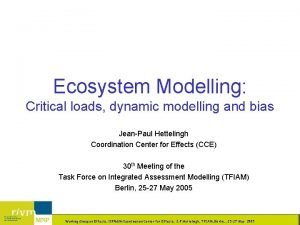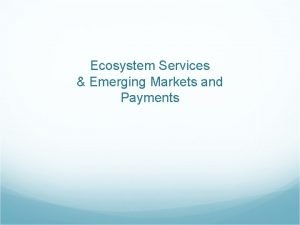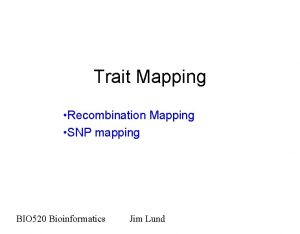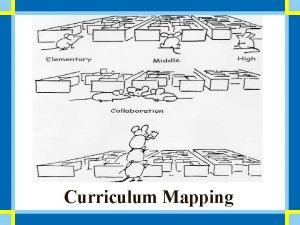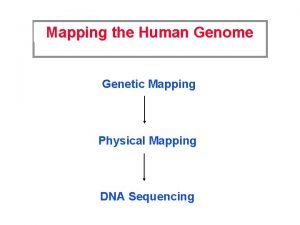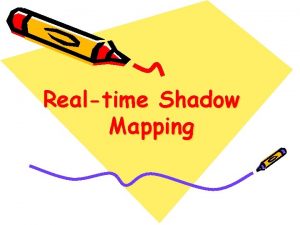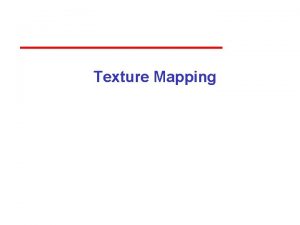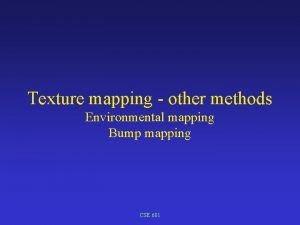Modelling and Mapping Ecosystem Services Topic 09 Learning






























- Slides: 30

Modelling and Mapping Ecosystem Services Topic 09

Learning outcomes • Explain why modelling plays a key role in mapping and valuing ecosystem services • Compare and contrast the different models used in mapping and valuing ecosystem services (process-based vs proxy-based models) • Develop, analyse and assess the performance of simple ecosystem models using appropriate modelling software

What are ecosystem service models? • Simplified representations of reality • Represent the processes in ecosystems that result in services • Can be conceptual or computer based • Very often focused on creating spatial outputs • Processes can be captured by sets of equations or proxy variables or simply identified as positive or negative

What is a conceptual model? “…. . precise and complete representations that are coherent with scientifically accepted knowledge” (Greca and Moreira 2000) • a mental model of how things in our surrounding environment work • based on information received through scientific data and observations • important diagnostic tool, widely used in meteorology

Conceptual model for understanding ecosystem services

Class Exercise: Imagine a Conceptual Model • Working in groups of three or four come up with various conceptual models for an issue of your interest (make sure everyone contributes)

Considerations when modelling to map ecosystem services

Why do we create models to map ecosystem services? • Change in ecosystem services • Flow of benefits and human wellbeing • Extrapolation to large regions • Limited data • Future scenarios and policy • Resource allocations

Understanding the spatial flow of benefits (Fisher et al. 2009; Bagstad et al. 2013) Christopher, T. (2012) © Institute for Natural Resources (http: //oregonexplorer. info/content/multiple-facets-ecosystem-services)

Modelling ecosystem services: Levels of complexity Simple models Less data (type, resolution, frequency, etc) Complex models More data Less accurate (predictions, representation, etc) Less utility (scenario/policy assessment, etc) Greater ease of use (training, software, etc) More accurate More utility Lesser ease of use

Process-based models and simpler proxy-based approaches

Process-based models • Models that aim to provide a framework for - Assessing - Mapping - Valuing specific ecosystem services • Often used for modelling - Ecological processes - Social processes - Economic processes

Biophysical inputs Land use/Land cover + associated factors affecting soil loss and retention Slope Rainfall erosivity Streams Watersheds Sediment thresholds (of reservoirs or water quality requirements) Soil erodibility © Natural Capital Project 2013

© Natural Capital Project 2013

© Natural Capital Project 2013

National land cover retention benefits (example of South Africa)

Proxy-based models • Simplest approach to modelling or representing a service • More commonly available than maps based on primary data - Often based on digital raster land cover maps, e. g. • ‘spatial value transfer’ (Troy and Wilson 2006) / ‘benefits transfer’ (Plummer 2009), - May integrate knowledge from multiple existing datasets, e. g. • Mapping the distribution of flood control and rural recreation services (Chan et al. 2006) • Accounting for proximity to settlements near water bodies (Troy and Wilson 2006) • Soil retention in South Africa (Egoh et al. 2008)

Modelling and mapping ecosystem services in practice Case study of Cape Town

Case study: Modelling ecosystem services in Cape Town (O’Farrell et al. 2012) • Aim - To provide information for city planners and biodiversity managers about the value of natural green spaces in terms of provision of ecosystem services • Method: - Land use and land cover change assessment - Potential contributions of natural vegetation remnants to specific ecosystem services

Assessing ecosystem services in the City of Cape Town

Assessing ecosystem services in the City of Cape Town

Assessing ecosystem services in the City of Cape Town Past land use Present land use Future land use

Assessing ecosystem services in the City of Cape Town Vegetation types with services values / measures / proxies

Natural vegetation average condition (Medium) Natural vegetation poor condition (Poor) Cultivated Forest Plantations Urban / Built-(up industrial) Urban / Built-up (Formal housing) Urban / Built-up (Informal housing) Urban / Built-up (smallholdings) Mines & Quarries Land capability 10 9 8 10 10 0 Grazing 10 6 3 0 0 0 0 Flood mitigation 10 9 7 5 9 0 5 3 8 0 Soil retention 10 8 7 7 9 10 9 5 9 0 Critical infiltration 10 8 5 8 9 0 8 5 8 0 Coastal zone protection 10 8 5 2 7 5 3 2 3 0 Groundwater recharge 10 9 7 7 5 2 6 4 6 5 Ground water yield 10 9 7 9 5 2 6 4 9 5 Ground water quality 10 10 10 6 9 4 7 5 5 5 Ecosystem service Natural vegetation good condition (High) Ecosystem services scored for different land-use classes based on expert opinion

Assessing ecosystem services in the City of Cape Town

Provisioning and regulating services

Assessing ecosystem services in the City of Cape Town

Cape Town: Some conclusions regarding simple approaches to ecosystem service assessment • Natural vegetation remnants vary in importance for ecosystem services - Provisioning – declining importance - Regulatory – very important but being eroded - Cultural – potential for greater importance • Arguments for conservation • Value of a simple rapid assessment tool • “Introduction to” tool and getting conversations going between departments

References Key readings • Bagstad, K. J. et al. (2013) Spatial dynamics of ecosystem service flows: a comprehensive approach to quantifying actual services. Ecosystem Services 4: 117 -125. • Chan, K. M. A. et al. (2006) Conservation planning for ecosystem services. Plos Biology 4: 2138 -2152. • O’Farrell, P. et al. (2012) Insights and opportunities offered by a rapid ecosystem service assessment in promoting a conservation agenda in an urban biodiversity hotspot. Ecology and Society 17: 27. • Plummer, M. L. (2009) Assessing benefit transfer for the valuation of ecosystem services. Frontiers in Ecology and the Environment 7: 38 -45. Other readings • Egoh, B. et al. (2008) Mapping ecosystem services for planning and management. Agriculture Ecosystems and Environment 127: 135 -140. • Fisher, B. , Turner, R. K. and Morling, P. (2009) Defining and classifying ecosystem services for decision making. Ecological Economics 68: 643 -653. • Greca, I. M. and Moreira, M. A. (2000) Mental models, conceptual models, and modelling. Int. J. Sci. Educ. 22(1): 1 - 11. • Tallis, H. T. , et al. (2011) In. VEST 2. 1 beta user’s guide. the natural capital project. • Troy, A. and Wilson, M. A. (2006) Mapping ecosystem services: practical challenges and opportunities in linking GIS and value transfer. Ecological Economics 60: 435 -449

Class exercise for further discussion • Identify a situation in your country, town or region in which decision-makers might need information about a specific set of ecosystem services. Based on your knowledge of the data that might be available, work through the 5 steps in Bullock and Ding (2018) and decide which ecosystem service model would be most useful for the decision-makers. • Bullock, J. M. and Ding, H. (2018) A guide to select ecosystem service models for decision-making. WRI, CEH and ESPA. Available at: - https: //www. espa. ac. uk/files/espa/18_Guide_Ecosyst em_Services_web_Feb 8. pdf -
 Example of specific topic
Example of specific topic Narrow topic examples
Narrow topic examples The associative mapping is costlier than direct mapping.
The associative mapping is costlier than direct mapping. Forward mapping vs backward mapping
Forward mapping vs backward mapping Terjemahan
Terjemahan Cuadro comparativo de e-learning
Cuadro comparativo de e-learning Changes in the global value of ecosystem services
Changes in the global value of ecosystem services Changes in the global value of ecosystem services
Changes in the global value of ecosystem services What are ecosystem services?
What are ecosystem services? Ecosystem services
Ecosystem services Ecosystem services
Ecosystem services Cbt exam format
Cbt exam format Basic geometric commands in cad/cam
Basic geometric commands in cad/cam Modelling relationships and trends in data
Modelling relationships and trends in data Problem solving and modelling task example
Problem solving and modelling task example Topic ex
Topic ex What is technological modelling
What is technological modelling Homology modelling steps
Homology modelling steps Modeling tools in java
Modeling tools in java Molecular modelling laboratory
Molecular modelling laboratory Modelling madness what's new
Modelling madness what's new Modeling rich interaction in hci
Modeling rich interaction in hci Lbo model test
Lbo model test Homology modelling steps
Homology modelling steps Hair modelling
Hair modelling Embedded systems product development
Embedded systems product development Homology modelling steps
Homology modelling steps Advanced process modelling
Advanced process modelling Mathematical modeling of electrical systems examples
Mathematical modeling of electrical systems examples Flight level
Flight level Unit 5 data modelling assignment 2
Unit 5 data modelling assignment 2








